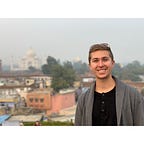A Semester in India: Mumbai
“The thing about Mumbai is you go five yards and all of human existence is revealed. It is an incredible cavalcade of life, and I love that.” — Julian Sands, British actor
MUMBAI, Maharashtra —After our tour group’s arrival to Mumbai, our new guide, who is from northeast India which has deep Southeast Asian roots, picked us up. While driving through Mumbai, we immediately witnessed unique aspects previously unseen during our trip: sizable skyscrapers, a strikingly young demographic, and ubiquitous Western clothing. With twenty-eight billionaires, Mumbai has the sixth largest number of billionaires in the world and is one of the world’s wealthiest cities.
After settling in at our hotel, we visited Dharavi, one of the world’s largest slums, which Slumdog Millionaire helped to make famous. In an area of 0.81 square miles, 700,000 people live. Despite the news articles and blogs depicting Dharavi as a crime- and violence-enveloped locale, the part that we visited displayed friendly people hard at work and very little trash in the alleyways. Lining the streets, countless repair shops bustled with shoppers. After visiting a bakery and a pottery shop, we departed to Dharavi’s antithesis: Bandra,
A popular coastal suburb where many Bollywood stars live, Bandra holds the luxurious homes of Bollywood superstars Shah Rukh Khan and Salman Khan. Small illegal slums occassionally appeared next to some of these million dollar homes in Bandra. While many of the structures are illegal and dangerous for the inhabitants, removal of the slums is political suicide.
After visiting , we went to Bandra Fort which is a famous lookout along the Mumbai coastline. There, couples cuddling in public was noticeably different from other cities in India. In regions of India where we had previously visited, public displays of affection were rare, but couples embracing each other or holding hands was a common sight in Mumbai. From couples dressed in Western clothes to women wearing the hijab or niqab, clasping teenage and young adult couples were prevalent throughout the city.
The strangest place where we saw young couples together was next to the highway. At night, we passed many motorcycles next to the road where couples were cuddling each other. Our guide told us that the public PDA was done in such odd locations in order to avoid detection by their parents and fellow community members.
Early the next morning, we explored a flower shop bustling with sellers providing cut rate prices and buyers requesting prices to be even lower, and then we visited the world’s largest outdoor laundromat, Dhobi Ghat. Even in the jungle of clothes, clothes are hardy ever lost or mixed up.
Next up was Mani Bhavan, which is where Gandhi launched many of his political movements while he was in Bombay. From there, we visited a Koli fishing village, which included fish vendors and shanties directly on the ocean shore.
Following, we saw the Gateway of India and then Chhatrapati Shivaji Terminus, previously known as Queen Victoria Terminus. Known as one of the busiest train stations in the world, the cars here are designed to hold 1,800 passengers but often carry 7,000.
Following our lunch of thali — a large round platter with various food items, we visited the Hanging Gardens and passed by the Parsi Tower of Silence. Notably, Parsis — a Zoroastrian community who left Persia and emigrated to India after the Arab conquest of Persia — do not bury or cremate their dead, instead they place their dead in the Tower of Silence to be eaten by vultures.
After this final tourist location, we bid adieu to our fellow American travelers who were returning to the U.S. that night. My mother and I stayed in Mumbai for the next four days where we explored the area, relaxed by the pool, and met up with friends in Mumbai. It was some of the most loving and generous hosting that I have ever experienced. They all went far above and beyond any hosting to make us feel at home in India. Indeed, I am looking forward to making this my home for the next three months. Next stop: Delhi.
